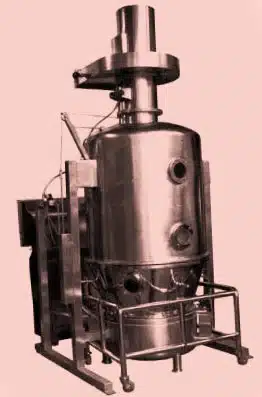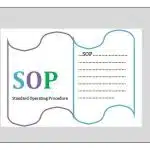Explore the principles & applications of Fluid Bed Dryer(FBD), a crucial technology in the pharmaceutical industry. Learn about the principles, mechanism, benefits, and key applications of FBDs for efficient drying and processing of powders, granules, and other materials. In this article, we will explore the principles behind fluid bed drying, its working mechanism, and its industrial significance.

Principles of Fluid Bed Dryers
At the core of the fluid bed dryer lies the principle of fluidization. Fluidization is a process where solid particles, when subjected to an upward flow of gas (usually air), are suspended in a fluid-like state. The interaction between the solid particles and the gas stream allows for efficient heat transfer and drying.
Here are the key principles governing fluid bed drying:
Fluidization: When air is introduced at high velocity through a perforated distributor plate at the base of the drying chamber, it lifts and suspends the particles in the air stream. These suspended particles begin to behave like a fluid, hence the term “fluidization.” This creates a large surface area for effective contact between the air and the material, facilitating quick and even drying.
Heat Transfer: Once the material is fluidized, hot air is passed through the drying chamber. The high surface-to-volume ratio between the hot air and the particles allows for efficient heat exchange. The moisture from the particles is evaporated by the heat, and the evaporated vapor is carried away by the exhaust air. As a result, drying is rapid and energy-efficient.
Mass Transfer: As moisture evaporates from the material’s surface, a moisture gradient forms, pulling moisture from the interior of the particles to the surface. This process continues until equilibrium is reached, ensuring uniform drying throughout the material. The exhausted air, laden with moisture, exits the system, maintaining a low moisture content inside the dryer.
Temperature Control: Temperature regulation is critical to prevent the degradation of heat-sensitive materials. In a fluid bed dryer, precise control of air temperature ensures that the drying process is both efficient and gentle, preserving the integrity of the material.
Mechanism of a Fluid Bed Dryers
Material Loading: The wet material, typically in granular or powder form, is loaded into the fluid bed dryer’s chamber. The material is evenly distributed on the perforated plate to ensure uniform fluidization.
Airflow Initiation: Once loaded, hot air (or gas) is introduced from below the perforated plate. The velocity of the air is carefully controlled to lift the particles into a fluidized state, suspending them in the drying chamber.
Drying Process: As the particles are suspended, hot air flows around them, and heat is transferred from the air to the particles. The moisture in the material evaporates, and the resulting vapor is removed with the exhaust air, leaving behind dry material.
Exhaust and Filtration: The exhaust air, which contains moisture and dust particles, is passed through filters to capture any fines, ensuring environmental safety and efficient drying. The clean air is released into the atmosphere, and the dried material is collected from the dryer.
Product Discharge: Once the drying process is complete, the air supply is turned off, and the dried material is discharged from the bottom of the fluid bed dryer. The dry product is ready for further processing or packaging.
Advantages of Fluid Bed Dryers
Efficient Heat Transfer: The fluidized state of the particles allows for excellent contact between hot air and material, resulting in faster and uniform drying.
Short Drying Time: The high heat and mass transfer rates in fluid bed dryers significantly reduce drying times compared to other conventional methods.
Energy Efficiency: The continuous airflow and rapid drying process consume less energy, making it an economical choice for large-scale drying operations.
Gentle Drying: Temperature control prevents overheating, making fluid bed dryers ideal for heat-sensitive materials.
Uniform Drying: Fluidization ensures that all particles receive equal exposure to hot air, leading to consistent drying.
Applications of Fluid Bed Dryer
Fluid bed dryers are widely employed in pharmaceutical industry such as:
Drying of Granules in Tablet Manufacturing
Granulation is a critical step in tablet production, where powdered materials are aggregated to form granules. After the granulation process, these granules typically contain a significant amount of moisture. Fluid bed dryers are used to dry these granules to the required moisture level, ensuring they are suitable for further processing like compression into tablets.
Drying of API (Active Pharmaceutical Ingredients)
Fluid bed dryers are used to remove moisture from active pharmaceutical ingredients (APIs). This is essential because moisture can affect the stability, potency, and shelf-life of APIs. FBDs offer precise control over drying temperatures, helping to preserve the sensitive nature of these ingredients.
Drying of Excipients
In addition to APIs, excipients (inert substances mixed with active ingredients) also require drying. For example, lactose, microcrystalline cellulose, and other fillers may need to be dried to a specific moisture level before they are mixed with APIs. FBDs are used to ensure uniform drying of these excipients.
Coating of Particles and Pellets
In fluid bed dryers, coating solutions can be sprayed onto particles or pellets while they are suspended in the airflow. This process is used for controlled-release formulations, taste masking, or improving the stability of APIs. The drying function of the FBD helps solidify the coating quickly and uniformly.
Encapsulation of APIs
Some drug formulations require encapsulation of APIs in a protective layer. Fluid bed dryers can be used to apply coatings around individual granules or pellets, providing a controlled release mechanism or protecting the API from environmental factors.
Preparation of Sustained-Release Formulations
Fluid bed dryers are utilized in the manufacturing of sustained-release or extended-release drug formulations. By coating granules or pellets with specific polymers, FBDs allow for the gradual release of the API over time.
Sterilization and Decontamination
Fluid bed dryers can be used to sterilize or decontaminate pharmaceutical powders by using high-temperature drying techniques, ensuring that the final product is free of microorganisms and contaminants.
Solvent Recovery
In some cases, fluid bed dryers are used when APIs or formulations contain volatile solvents. FBDs are effective in drying the product while allowing for solvent recovery, ensuring compliance with environmental and safety regulations.
Heat-Sensitive Materials
The gentle drying mechanism of fluid bed dryers makes them suitable for heat-sensitive materials. By controlling the drying temperature and airflow, FBDs minimize the risk of thermal degradation of the product.
Uniform Particle Drying
The fluidized bed process ensures that particles are suspended in the airflow, allowing for uniform exposure to the drying air. This results in consistent moisture content across all particles, which is critical for producing high-quality pharmaceutical products.
Conclusion
The fluid bed dryer is a versatile and efficient tool for industrial drying applications. Its reliance on fluidization, heat, and mass transfer principles allows for quick, uniform, and energy-efficient drying.
Related Topics:
- Common Tablet Defects and Remedies in Manufacturing
- Difference Between Drugs and Medicines
- Cefixime Trihydrate PFS Formulation and Manufacturing Process 2024
- Azithromycin PFS Formulation and Manufacturing Process

Abdus Sobhan Salim is professional experienced pharmacist in pharmaceuticals, author and founder of pharmabossbd.com, the first Bangladeshi pharmaceutical blogger since 2019.



